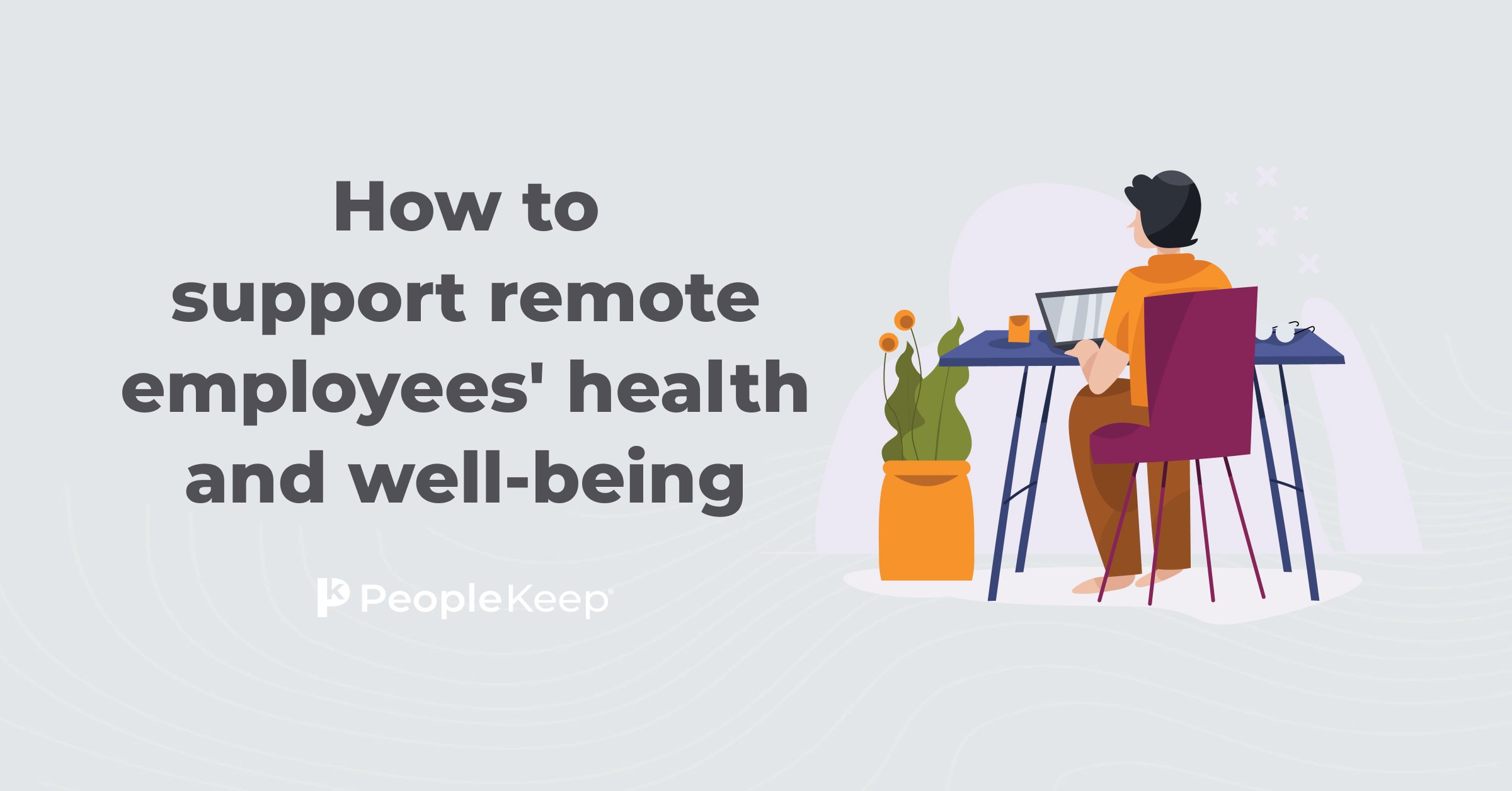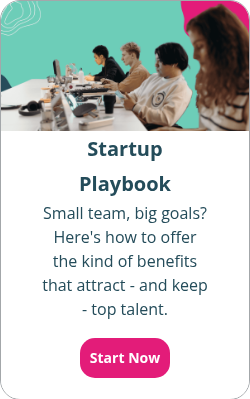How to attract job candidates as a startup
By Chase Charaba on April 11, 2024 at 6:47 AM
The United States is a hotbed for tech startups. Some of the most successful companies in the world began as startups in the U.S., including SpaceX, Stripe, Instagram, Airbnb, Epic Games, and DoorDash, to name a few.
According to Statista1, 15.4% of the U.S. population is either an owner, partner, or employee of a tech startup.
With many private startups hoping to reach unicorn status—a valuation of $1 billion or more—acquiring and retaining top talent is essential.
Because early-stage startups are highly competitive and volatile, it can be hard to sway job candidates to apply or take a position at a small startup versus larger companies. Many small businesses have limited capital and fewer benefits than larger organizations. However, even as an employer at a small startup company, you can create a competitive compensation package and become an employer of choice without breaking the bank.
In this article, we'll share some startup hiring tips and go over which benefits are most effective at recruitment.
Takeaways from this blog post:
- With limited resources and a smaller brand presence, it's often difficult for startups to compete with larger companies for talented job candidates.
- Attracting job candidates as a startup requires a strategic approach that showcases your company culture, values, and growth potential.
- While startups may not always be able to offer the same salary and benefits packages as larger corporations, it’s important to provide competitive compensation and benefits to attract top talent.
Write job descriptions that stand out
If you want to run a successful startup, it starts with your job descriptions. They shouldn't be an afterthought. This is a job seeker's first impression of your company. It's your time to convince them why they should work for you.
Effective job descriptions should include the following:
- Job title
- Job summary with an overview of the role
- Job responsibilities and duties
- Qualifications and skills required or desired
- What your organization does and why it matters
- Annual salary or salary ranges
- Additional benefits you provide
Build a strong online presence
One of the first things job candidates will do when considering a job opportunity at your startup is research your company online. Make sure your website and social media profiles are up to date and showcase what your company is all about.
You should also post job listings online as part of your recruitment strategy. This can help reach a larger pool of candidates both nationally and internationally. You can recruit plenty of talented people by sharing job posts on social media platforms like LinkedIn, Facebook, and Instagram. You can also reach potential hires through general job boards, such as Indeed or Monster.
Explain your interview process
Potential employees appreciate a quick, effective hiring process. Most people on the job hunt won't wait around for a decision if you're dragging your feet. They expect a timely response letting them know if you're interested in them. If you fail to keep them informed, they may move on to the next employment opportunity. Let potential employees know what they can expect during the interview process, such as if they're in-person or remote, how many rounds there may be, and if you require any skills assessments.
Strong employers should also prepare questions in advance to ensure an effective hiring process. Familiarize yourself with each candidate's resume before their interview. Adding a few more personalized interview questions can help you avoid making a bad hire.
Highlight what makes your company special
A major perk of working at a startup business is that people get to know each other better and on a more personal level since there are fewer employees. While your financial capital may not be able to compete with larger businesses in Silicon Valley or Seattle, your startup culture can.
There are many steps you can take to create a positive company culture. Documenting your company values and vision is a significant first step. In addition, being open and honest with your employees can help boost morale and productivity because employees will feel aligned with your organization's goals and that their voices are being heard.
By ensuring your employees are engaged and having fun at work, you can boost employee loyalty and attract employees who are the best culture fits for your startup.
Utilize employee referral programs
Another effective way to attract quality candidates to your startup is through employee referrals. Ask the curated team of people you've already hired for their recommendations. Skilled employees who are happy in their roles will likely recommend their friends and former colleagues. Having a list of people that match the skill sets and personality traits of your current employees can save you valuable time in the recruiting process.
You can offer incentives to your current employees who refer ideal candidates, such as a monetary bonus or extra paid time off (PTO).
Offer startup benefits and perks
Although traditional benefits are still an important part of a competitive employee benefits package, the needs of your employees are changing. You'll need to offer a wider range of benefits and additional perks to attract the most qualified candidates.
While large corporations can afford to offer in-house massages, employee retreats, and catered lunches, perks don't always need to be extravagant.
The following sections will explore the array of benefits and perks that startups can implement.
Health benefits
Group health insurance is expensive. While many startups believe they can't afford to offer healthcare benefits, this couldn't be further from the truth. There are many benefits options available other than traditional group health insurance.
A health reimbursement arrangement (HRA) is a popular option among organizations that want to offer a flexible, affordable, and personalized benefit to their employees. An HRA is an IRS-approved, employer-funded health benefit you can use to reimburse your employees for their qualifying medical expenses. Depending on the type of HRA, this can include individual health insurance premiums. Simply set a monthly allowance for your employees to use and approve their eligible expenses up to their allowance.
The best part about offering an HRA to your employees is that it’s tax-free for you and your employees, as long as they have a health insurance plan with minimum essential coverage (MEC).
There are a few popular types of HRAs available, including:
- Qualified small employer HRA (QSEHRA)
- A QSEHRA is for organizations with fewer than 50 full-time equivalent employees (FTEs) that don’t offer a group plan. It allows you to reimburse employees for insurance premiums and out-of-pocket expenses.
- Individual coverage HRA (ICHRA)
- An ICHRA is an excellent option for businesses of all sizes that want to offer custom allowance amounts to different employee classes. It allows you to reimburse employees for individual health insurance premiums and out-of-pocket expenses. It can also help organizations with 50 or more FTEs satisfy the Affordable Care Act’s employer mandate.
- Group coverage HRA (GCHRA), also known as an integrated HRA
- A GCHRA is a way to supplement your existing group health insurance, such as a high deductible health plan (HDHP), to reduce employees’ health costs.
You could also offer your employees a taxable health stipend. While HRAs are often a better fit for most organizations due to their tax-advantaged status, there are some medical expenses that HRAs don't cover. Health stipends also provide the flexibility to offer health benefits to your 1099 contractors and international workers.
Fringe benefits
Fringe benefits are a form of indirect compensation employers provide to employees alongside their wages or salary. While people often use the term fringe benefits to refer to any employee benefit, the IRS defines a specific list of non-traditional benefits in Publication 15-B.
Some examples of fringe benefits include:
- Achievement awards
- Adoption assistance
- Commuter benefits
- De minimis benefits
- Educational assistance
- Employee discounts
- Life insurance
- Retirement planning services
While some fringe benefits can be expensive and complex to administer, others, such as employee stipends, can be relatively inexpensive to implement as company benefits. You can offer stipends for expenses relating to wellness, home office, transportation, travel, and more.
A taxable wellness stipend is a great place to start. With a wellness stipend, you can choose an affordable monthly allowance that your employees can use to be e reimbursed for their wellness expenses. This means that you have complete control over the cost of your wellness stipend benefit, whether that's $50 per employee or $300. You can reimburse employees for their gym memberships, home exercise equipment, and more. This gives your employees the freedom to choose which wellness expenses they want to have reimbursed from their monthly allowance.
You can also offer a remote work stipend if you have remote employees. Similar to a wellness stipend, this allows you to reimburse your employees—this time for their home office expenses, including internet access, cell phone bills, and home office set-up costs, to name a few examples.
Other perks to consider
Your startup can offer many other perks to help attract and retain employees and improve your workers' job satisfaction.
Perks to consider adding to your benefits program include:
- Flexible hours
- Unlimited PTO
- Remote work
Offering remote work and flexible schedules is a great way to attract nationwide talent, not just those in your local area. By allowing your employees to work anywhere, you'll be able to hire more talent from tech hubs like Seattle, the San Francisco Bay Area, Austin, or Boston, especially with companies like Tesla2 announcing that they'll be doing away with remote work.
PTO is also an essential benefit that will help you recruit more young employees, such as Gen Zers and millennials, who favor time off and flexibility instead of more traditional benefits.
Promote opportunities for advancement within your organization
Another way startups have the upper hand on larger organizations is that your skilled employees have more opportunities for career advancements. Your employees and potential recruits have the chance to become part of something progressive and dynamic.
Be sure to highlight these opportunities with employees and potential candidates. Let them know working for a startup will give them more opportunities to have their voice heard, make a difference, and get promotions.
Conclusion
By implementing these strategies, you can attract job candidates to your startup and build a strong team that will help your company grow and succeed. Remember to showcase your company culture, offer competitive compensation and benefits, and leverage employee referrals to attract productive employees who are passionate about your mission and vision.
If you're ready to offer flexible employee benefits, PeopleKeep can help! Our HRA administration software helps thousands of small businesses and startup companies manage their benefits in minutes each month.
This blog article was originally published on October 31, 2014. It was last updated on April 11, 2024.
Check out more resources
See these related articles

What can an HRA reimburse?
Wondering if your HRA can cover specific medical costs? Discover the comprehensive list of eligible expenses that your HRA can reimburse in this article.

Five tips to start offering employees health benefits
Learn five essential tips for offering health plans for employees. Discover how to choose the right benefits to attract and retain top talent.

How to support remote employees' health and well-being
Discover strategies for supporting the health and well-being of your remote employees with this comprehensive guide. Start taking care of your team today!



